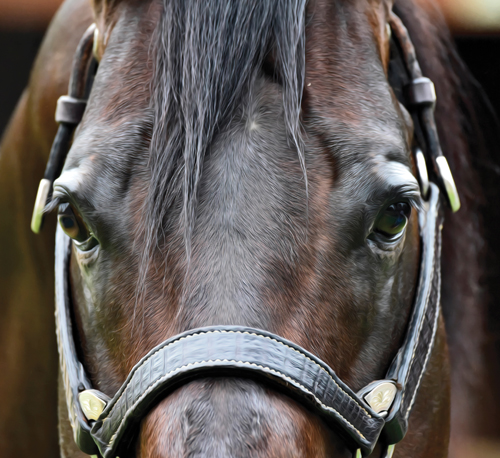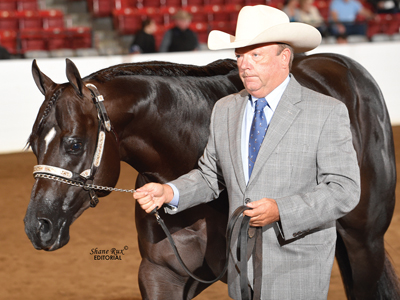 Whether you are showing a top contender at a World Championship Show or taking your riding partner in a Performance Halter Class at a weekend show, a properly fitted show halter is essential for a professional, polished look. Here we talk to trainers, exhibitors and halter makers about achieving that perfect look.
Whether you are showing a top contender at a World Championship Show or taking your riding partner in a Performance Halter Class at a weekend show, a properly fitted show halter is essential for a professional, polished look. Here we talk to trainers, exhibitors and halter makers about achieving that perfect look.
Taking the extra time to find the right fit and style of halter that is the most flattering to your horse’s head is key to success. AQHA Professional Horseman, Ross Roark, of Monahans, Texas, stresses the importance of having a well-fitted, clean halter when presenting a horse properly in a Halter class.
“A halter can help or hurt the overall presentation of the horse,” he said. “I would say about 75 percent of exhibitors have their halter set down too low on their horse’s head.”
Roark suggests taking time to decide what looks best on your horse’s head. For instance, a thinner halter often looks better on a younger or keener headed horse.
“Find the right size and use a halter that is attractive to your horse’s head,” he explained. “This can be difficult sometimes especially on yearlings in the spring when they are growing a lot.”
Instead of worrying about having a lot of silver on your halter, Roark believes it is most important to have your halter fitted correctly – which includes adjusting all the straps on the halter so that they fit up against the horse’s face.
“Don’t forget about the strap below the jaw,” he said. “A lot of people leave this too long and you want it to fit up and snug. Always remember to adjust all the straps on the halter so that it fits the best it can.”
With a proper fit in mind, Phil Harris of Harris Leather and Silverworks, State Road, North Carolina, said his family’s company designs show halters so they can be positioned to fit just right.
“Our halters are fully adjustable,” he said. “Our standard halter will fit just about any horse. For the unusual horse, we do offer custom work as well.”

Loose fittings underneath the halter (top left) give a poor fit. Adjust these up on the horse’s head for a proper fit. Poor fittings on adjustable straps and on crown piece (top right) make the halter sit too far down on the horse’s nose and makes the side of the halter fit too loose going up into the horse’s eye area. The bottom picture shows a correct fit.
Of course starting with the right size halter to begin with is important. Harris offers standard sizes for weanling, yearling, mare 2-year-old and full size halters.
“In addition we also offer different size crown pieces,” he said. “Sometimes a halter will fit the horse but needs a different length crown piece.”
Harris show halters are made of only the finest materials. In fact, the leather used for show halters comes from the backs of the cows instead of the sides of the cow as many other halters are made of.
“We use the backs of the cow for a tighter grained leather which holds its shape better,” he said. “We found this leather to consistently fit better on a horse’s head. We also use stainless steel rings instead of square rings.”
Phil’s father, Ralph has been making show halters for over 35 years. He still goes over every stitch searching for perfection in their show halters before they are sent to the public. And Phil’s brother, Eddie does all the sliver work on the show halters.
“We offer many different designs from gold to silver inlay with scrolls as well as custom silver work,” he said. “The most popular though are the engraved squares.”
With the proper halter and fit, judges get a good impression right from the track in says AQHA Professional Horseman, Dewey Smith, of Bellefontaine, Ohio. “I think there are a lot of exhibitors who do not realize that you are being judged right from the time you enter the gate and the first thing the judge sees is the horse’s head,” he said. “If your halter does not fit properly, you look unprepared and this can turn the judge off right from the start.”
Smith prefers smaller or swage buckles on his halters over a larger buckle.
“Sometimes if the buckle is too large, they can actually pinch the horse’s ears and this can cause the horse to not want to use their ears good when you are showing them,” he says.
When showing stallions with a lip cord, Smith advises adjusting your halter’s nose band extra snug.
“If the nose band is too loose, the lip cord will pull the nose band down too far on the horse’s head and it also gives a false impression that the exhibitor is using lot of extra pressure on the cord,” he explained. “It is very important that your halter fits properly up on the horse’s head.”

Ross Roark
Longtime Halter trainer, Todd Grant, of Newnan, Georgia, concurs.
“You want a halter to fit up on your horse’s face,” he said. “Use a style that looks best on your horse and make sure it is clean. I really think the key though is the right fit.”
In fact, Grant believes a lot of nice horses get missed in the arena because of poorly fitted halters and presence.
“It’s just human nature to go by a horse without a fitted halter,” he said. “It’s like going around in the Western Pleasure with a loose cinch. It’s just not going to work.”
When choosing the right halter for your horse, Grant suggests considering your horse’s strengths and weaknesses.
“If your horse has a longer ear you may want to use a bigger buckle or if they have a real keen head then use a small buckle or even a keeper on them,” he said.
In the Performance Halter class, Grant thinks it is especially important to try to find a style that can set you and your horse apart.
“The Performance Halter has become such a tough class, you have to make sure your halter is fitted up on your horse’s face and you are getting shown,” he revealed. “I also look for something a little different in style, which is flattering to your horse and helps to make them stand out.”
Aside from the traditional silver show halters, Grant also uses exotic leathers like alligator, a buck-stitch design, or even a plain leather halter with sliver buckles.
“I don’t think the more silver on the halter the better,” he said. “A nice, clean well- fitted halter is the key to a good presentation.”



You must be logged in to post a comment Login